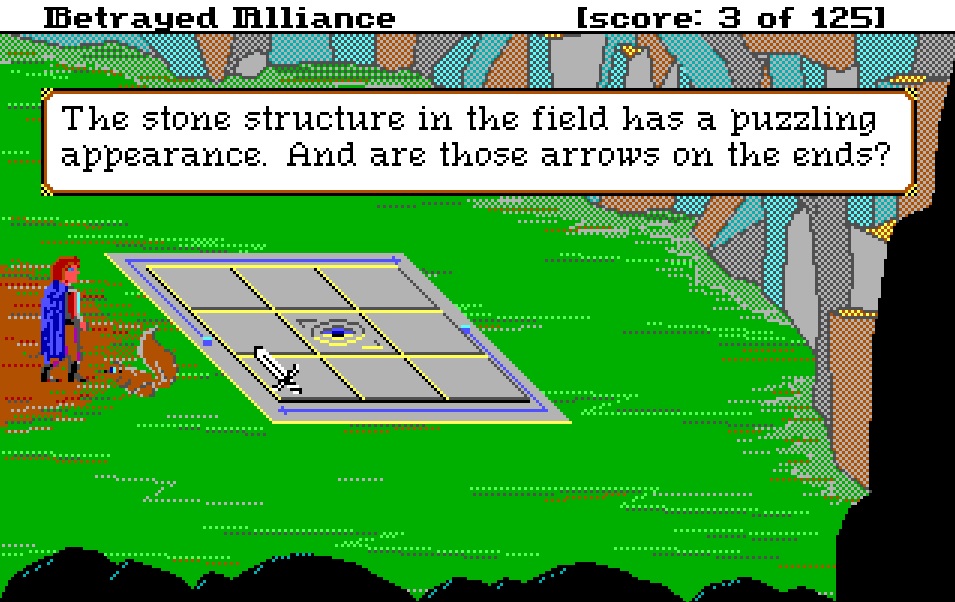I heaped myself a bunch of praise when I looked at the Overworld Structure for BA: Book 1. As much as I enjoy patting my own back, today I’ll be moving my hand to my forehead as we look at some puzzle choices.
The Squirrel Puzzle

This puzzle has three steps:
- 1. Activate the puzzle by giving the squirrel the acorn
- 2. Say “copy cat” to the squirrel and it will position itself to mirror your actions
- 3. Make the correct sequence of steps.

As a puzzle, it’s fine. Not earth-shatteringly good, not rip-out-your-hair-bad. The signposting to say “copy cat” is clear once you’ve heard the dialog from the soldiers watching the Whispering Caverns. The signposting for the correct sequence of steps is carved into the puzzle structure itself, which is also told to the player if they happen to “look at” the puzzle board itself.

What’s wrong with it?
The design feels arbitrary. Simply put, why is it there, other than just another obstacle for the player? And what reason is there for a squirrel?
It breaks the immersion when it’s just some random puzzle.
What’s worse is that it was designed with a story purpose, but very little made it into the game.

The puzzle leads to a hidden grove, meant to be a “special place” for the main villain (Gyre) and his wife, who had died before the events of the game. The spirit of the wife “haunts” the place playing music, which has led to the spread of the legend of the “Muse of the Mountain.”
The puzzle needing two participants was originally set up for Gyre and his wife to gain access to their secluded sanctuary. With her passing, Gyre had trained an animal to replicate the pattern so he could still gain access. I never devised a way to get this information into the game, sadly. About all that made it into the game were the rumors about the “Muse of the Mountain” which you find in an optional library book.

Why do the tiles make sounds?
From its inception it was designed to be a music-puzzle, where the player (along with the squirrel) would repeat the four chords of a song that could be heard playing if one listened near the entrance.
The woman/spirit the player finds is seen to play music and sings all of her dialog. The lore is that people can hear her singing, but Gyre cannot due to his heart being clouded with thoughts of revenge.

So what happened? I hadn’t considered the limitations of sound in SCI, particularly the ability to only play back one sound at a time. The idea was each block played a tone, but when the player and squirrel would step on two different blocks, it would play two sounds making a small chord. That didn’t work at all because it couldn’t!
A concession was made to add arrows onto the puzzle board itself and remove any correspondence to the notes and the solution. The puzzle became more of a dexterity challenge than a music puzzle in the end.
I have regrets…
While the puzzle is generally fine in a vacuum, I do regret how I poorly I translated the puzzle from design to execution. I feel it lost almost all of its story meaning, and most of its original puzzle design as well.
It wasn’t until about the last month or two before release I had (for other reasons) decided to use “SCI Audio” which would open a parallel program that plays music separately from the game program. This program did allow for multiple tones at once, but at that point, the puzzle was already in place and the release was coming too soon to go back and change things.
Redeeming features
Yes, I have regrets, but this puzzle still has some things going for it.
- It adheres to the “find the lock before the key” rule, while also allowing you to play around a bit with it (if you give the Squirrel the acorn).
- While the notes no longer matter, it is generally fun to play with them.
- The player will typically go through a series of trial and error efforts like “pressing down all the tiles” before leaving the puzzle or solving it. It’s generally good if the puzzle’s not so easy the player gets it straight away.
Who cares what I think?
It’s your opinion that matters, not mine. I just made the puzzle, you got to play it. So what are your impressions?

